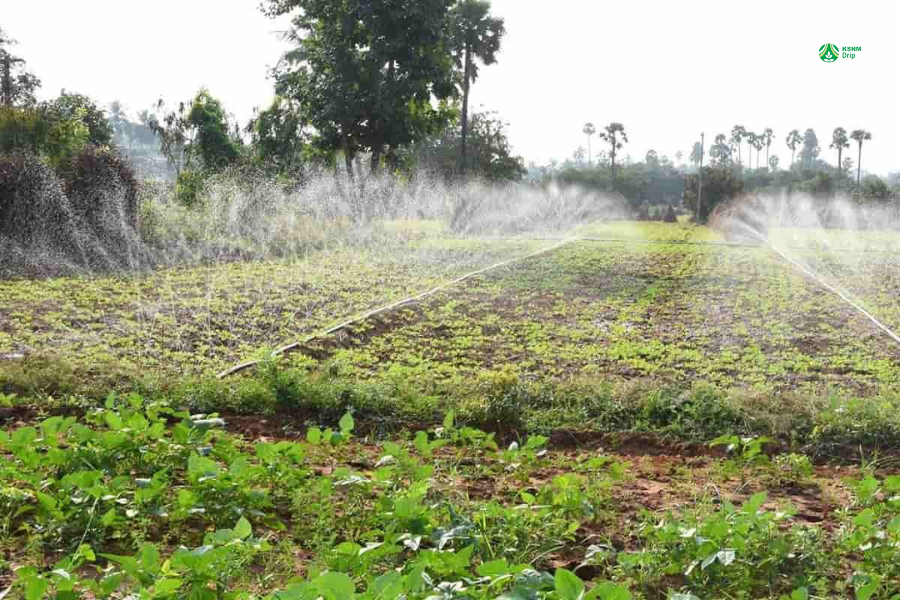Posted On: May 15, 2024
Posted By: KSNM DRIP

Rain hose irrigation revolutionizes leafy vegetable cultivation by delivering water precisely to plant roots, mimicking natural rain. This efficient method conserves water, boosts crop health, and enhances yield. With its easy setup and cost-effectiveness, rain hose irrigation offers farmers a sustainable solution to optimize their vegetable production. Check out how to use rain hose irrigation in growing leafy vegetables and improve their yield.
Rain Hose Irrigation is a type of drip irrigation system that delivers water directly to the base of plants in a gentle, controlled manner, mimicking the effect of natural rain. It consists of a long, flexible hose with evenly spaced drip emitters along its length. These emitters release water gradually, allowing it to seep into the soil and reach the plant roots efficiently.
This system is particularly useful in areas with water scarcity or where water needs to be conserved. It helps minimize water wastage by delivering water precisely where it's needed, reducing evaporation and runoff. Rain Hose Irrigation is commonly used in agriculture, horticulture, and landscaping applications for watering crops, gardens, orchards, and nurseries.
Yes, rain hose irrigation is good for leafy vegetables like cabbage, lettuce, and spinach as this irrigation system can provide uniform water in a cost-effective setup. Rain hose uses sprinkler irrigation and it is the best for leafy vegetables, as it can provide water and at the same time make sure the leaves are clean and green.
Being one of the modern ways of irrigation, the rain hose irrigation method offers a lot of advantages to the farmers growing leafy vegetables. Here are some of the advantages you get by using sprinkler irrigation method using a rain hose,
Comparing rain hose irrigation with other types of traditional irrigation methods, it�s been found that you can save 70% more water by delivering water directly to the roots of your plants.
Nutrients required for your plants can be uniformly distributed in a precise manner, providing the necessary plant needs and helping it grow in good health.
There will be no worry about getting pests and this irrigation method reduces the amount of water wasted and makes sure to get rid of diseases.
The installation process of setting up a rain hose irrigation system for your leafy vegetable crops is quite easy.
By uniformly providing water and nutrients to your crops, you can see an increase in productivity and improve the profitability for the farmers.
The system comprises a main water supply line, rain hose tubing, pressure regulator, filters, and connectors. Emitters along the hose release water gradually, ensuring even distribution across the crop area.
Before installation, assess the field layout, water source availability, and crop water requirements. Design the system layout to optimize water distribution and minimize pressure loss.
Install the main water supply line along the field perimeter, connecting it to the source. Lay out the rain hose tubing parallel to crop rows, securing it with stakes or clamps. Ensure proper alignment and spacing of emitters for uniform coverage.
Calibrate the system to regulate water flow and pressure according to crop needs. Monitor and adjust settings as necessary to maintain optimal moisture levels throughout the growing season.
Regularly inspect the system for leaks, clogs, or damage. Clean filters and emitters to prevent blockages and ensure uninterrupted water flow. Replace worn-out components as needed to maintain efficiency.
Monitor soil moisture levels and plant health regularly to detect any issues early. Address factors such as overwatering, underwatering, or uneven distribution promptly to prevent crop stress or yield loss.
Optimize irrigation scheduling based on crop growth stage, weather conditions, and soil moisture levels. Implement mulching and canopy management techniques to reduce water loss and improve water use efficiency.
Rain hose irrigation promotes uniform growth and development in leafy vegetables, resulting in higher quality and yield. Proper moisture management reduces the risk of diseases and improves overall crop health.
By minimizing water usage and runoff, rain hose irrigation contributes to sustainable agriculture practices, conserving natural resources and minimizing environmental impact.
Evaluate the initial investment cost, operational expenses, and potential savings in water usage and labour. Calculate the return on investment based on increased crop productivity and reduced inputs over time.
To get more information about the rain hose irrigation setup, click on How To Set Up Rain Hose Kits?
Since rain hose provides water to crops in the form of rain, it is better suited for more vegetables than other crops. Here are some of the vegetables that are suitable for rain hose irrigation.
Rain hose irrigation emerges as a game-changer in leafy vegetable farming, offering numerous benefits such as water conservation, uniform nutrient distribution, and enhanced crop productivity. By harnessing this innovative technology, farmers can achieve sustainable growth, maximize profitability, and contribute to a greener future in agriculture. Make your rain irrigation more meaningful with rain hose kits from KSNM Drip.